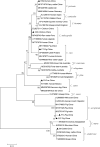Molecular characterization and zoonotic potential of Cryptosporidium spp. and Giardia duodenalis in humans and domestic animals in Heilongjiang Province, China
- PMID: 38528567
- PMCID: PMC10964600
- DOI: 10.1186/s13071-024-06219-3
Molecular characterization and zoonotic potential of Cryptosporidium spp. and Giardia duodenalis in humans and domestic animals in Heilongjiang Province, China
Abstract
Background: Cryptosporidiosis and giardiasis are significant parasitic diseases shared between humans and domestic animals. Due to the close contact between humans and domestic animals in rural areas, it is important to consider the potential transmission of zoonotic parasites from infected domestic animals to humans. This investigation aimed to determine the prevalence and molecular characteristics of Cryptosporidium spp. and Giardia duodenalis in domestic animals and villagers.
Methods: A total of 116 fecal samples from villagers and 686 fecal samples from domestic animals in Heilongjiang Province, China, were analyzed for two parasites using nested polymerase chain reaction (PCR) targeting various genetic loci and DNA sequence analysis of the PCR products.
Results: By sequence analysis of the SSU rRNA gene, the prevalence of Cryptosporidium in humans was 0.9% (1/116), with one species of C. parvum (n = 1) detected; among domestic animals, the prevalence was 2.6% (18/686), with five species identified: C. suis (n = 7) and C. scrofarum (n = 7) in pigs, C. meleagridis (n = 1) in chickens, C. andersoni (n = 1) in cattle, and C. canis (n = 2) in foxes. C. parvum and C. canis were further subtyped as IIdA19G1 and XXa4 on the basis of gp60 gene. Regarding G. duodenalis, based on the SSU rRNA, bg, gdh, and tpi genes, the prevalence in domestic animals was 5.1% (31/608), with three assemblages identified: A (n = 1) in pigs, D (n = 1) in foxes, and E (n = 27) in geese, cattle, pigs, ducks, and sheep, along with mixed infection of A + E (n = 1) in one pig and B + E (n = 1) in one sheep. No G. duodenalis was detected in humans (0/116).
Conclusions: The present results show that no overlap of subtypes between animals and villagers was found in Cryptosporidium spp. and G. duodenalis, indicating a minor role of domestic animals in infecting humans in this population. However, the presence of zoonotic protozoa in domestic animals highlights the need for special attention to high-risk individuals during close contact with domestic animals.
Keywords: Cryptosporidium spp.; Giardia duodenalis; Domestic animals; Epidemiology; Humans.
© 2024. The Author(s).
Conflict of interest statement
The authors declare that they have no competing interests.
Figures



Similar articles
-
Prevalence and molecular characterization of Cryptosporidium spp., Enterocytozoon bieneusi, and Giardia duodenalis in dairy cattle in Ningxia, northwestern China.Vet Res Commun. 2024 Aug;48(4):2629-2643. doi: 10.1007/s11259-024-10364-6. Epub 2024 Apr 3. Vet Res Commun. 2024. PMID: 38565798
-
Prevalence and Molecular Characterization of Cryptosporidium spp., Giardia duodenalis and Enterocytozoon bieneusi in Donkeys of Inner Mongolia, Northern China.Acta Parasitol. 2025 Jan 22;70(1):20. doi: 10.1007/s11686-024-00965-1. Acta Parasitol. 2025. PMID: 39838230
-
Prevalence and molecular characterization of Cryptosporidium spp. and Giardia duodenalis in dairy cattle in Gansu, northwest China.Parasite. 2020;27:62. doi: 10.1051/parasite/2020058. Epub 2020 Nov 18. Parasite. 2020. PMID: 33206594 Free PMC article.
-
A review of the molecular epidemiology of Cryptosporidium spp. and Giardia duodenalis in the Middle East and North Africa (MENA) region.Infect Genet Evol. 2022 Mar;98:105212. doi: 10.1016/j.meegid.2022.105212. Epub 2022 Jan 20. Infect Genet Evol. 2022. PMID: 35065302 Review.
-
Waterborne Cryptosporidium species and Giardia duodenalis in resources of MENA: A systematic review and meta-analysis.J Water Health. 2024 Aug;22(8):1491-1515. doi: 10.2166/wh.2024.107. Epub 2024 Jun 26. J Water Health. 2024. PMID: 39212283
Cited by
-
Occurrence rate and species and subtypes of Cryptosporidium spp. in pet dogs in Yunnan Province, China.BMC Microbiol. 2024 Sep 19;24(1):354. doi: 10.1186/s12866-024-03500-4. BMC Microbiol. 2024. PMID: 39294588 Free PMC article.
-
Evaluating prevalence, risk factors, and diagnostic techniques for Cryptosporidium infection in goats and surrounding water sources.Front Vet Sci. 2024 Dec 19;11:1498682. doi: 10.3389/fvets.2024.1498682. eCollection 2024. Front Vet Sci. 2024. PMID: 39748871 Free PMC article.
-
Cryptosporidium in cattle: Assessing the zoonotic risk.Curr Res Parasitol Vector Borne Dis. 2025 Jun 14;8:100279. doi: 10.1016/j.crpvbd.2025.100279. eCollection 2025. Curr Res Parasitol Vector Borne Dis. 2025. PMID: 40656159 Free PMC article.
References
-
- Karim MR, Zhang S, Jian F, Li J, Zhou C, Zhang L, Sun M, Yang G, Zou F, Dong H, Li J, Rume FI, Qi M, Wang R, Ning C, Xiao L. Multilocus typing of Cryptosporidium spp. and Giardia duodenalis from non-human primates in China. Int J Parasitol. 2014;44:1039–1047. doi: 10.1016/j.ijpara.2014.07.006. - DOI - PubMed
MeSH terms
LinkOut - more resources
Full Text Sources
Medical
Miscellaneous

